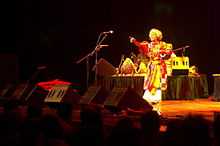Nazrul Geeti

| Music of Bangladesh | |
|---|---|
 | |
| Genres | |
| Specific forms | |
| Religious music | |
| Ethnic music | |
| Traditional music | |
| Media and performance | |
| Music awards | |
| Music festivals | |
| Music media |
Radio
Television
Internet |
| Nationalistic and patriotic songs | |
| National anthem | Amar Sonar Bangla |
| Other |
Chol Chol Chol Amar Bhaier Rokte Rangano |
| Regional music | |
| Related areas | |
| Other regions | |
Nazrul Geeti (Bengali: নজরুল গীতি) or Nazrul Sangeet (Bengali: নজরুল সঙ্গীত), literally "music of Nazrul", refer to the songs written and composed by Kazi Nazrul Islam, a Bengali poet and national poet of Bangladesh and active revolutionary during the Indian Independence Movement. Nazrul Sangeet/Geeti incorporate revolutionary notions as well as more spiritual, philosophical and romantic themes.[1] Nazrul wrote and composed nearly 4,000 songs (including gramophone records),[2] which are widely popular in India and Bangladesh.
Background
Nazrul showed the symptoms of keen poetic and musical talent at his tender age and started writing songs when he was a member of a Leto group (Folk Musical Group). Following Kazi Bazle Karim, his uncle and a leader of a Leto group, he became expert in composing songs and setting them to tunes. Joining Leto group enhanced his musical career and put a significant impact on shaping his future musical life. At very young age he was excelled in composing songs in different languages, apart from Bengali language. He met Satish Kanjilal, a teacher of Searsol School who had interest in classical music and some mastery over it. Observing Nazrul's irresistible inclination to music, Mr. Kanjilal imparted him some lessons on classical music. Later Nazrul widened his knowledge on music when he was serving as a Havilder in Karachi Barrack under Bengal Regiment. He learned a great deal of Persian language, literature and music with the help of a religious teacher from Punjab attached with the regiment.
Nazrul Islam's musical style
Revolutionary Mass music
The Mass music and poems of Kazi Nazrul Islam have been widely used during the Indian Independence Movement and Bangladesh Libaration War. The music is highly motivational and revolutionary in nature with strong and powerful words and captivating tunes. It talks about the extremities of everything. The lyrics of those songs are provoking, as they talk against conservatism and about life on a broader parameter of philosophy and spirituality. The beauty of Nazrul's mass music lies in the freedom of its expression, which also drew immense criticism. However, those who understood its philosophy praised the courage and straightforwardness.
Shyama Sangeet
Nazrul made valuable and rich contribution to Shyama Sangeet. He was thoroughly familiar with both Islamic and Hindu tradition and culture, and also he deeply cared about the harmony between Muslims and Hindus.
Ghazal
Nazrul's acquaintance with the tradition of Persian Ghazals, a form of love songs, was very significant in the sense that it paved the base of his successful efforts in composing Bengali Ghazals which he undertook by 1927-28. Bengali Ghazal is, it can be mentioned outright, an innovation by Kazi Nazrul Islam alone. It served as the first mass-level introduction of Islam into the mainstream tradition of Bengali music.
Historical influence
Nazrul used his music as a major way of disseminating his revolutionary notions, mainly by the use of strong words and powerful, but catchy, tunes. Among the revolutionary songs, Karar Oi Louho Kopat (Prison-doors of Steel) is best known and has been used several movies, especially those made during the pre-independence period of Bangladesh.
Notable songs
- Dolan Chapa (name of a faintly fragrant monsoon flower), poems and songs, 1923
- Bisher Bashi (The Poison Flute), poems and songs, 1924
- Bhangar Gan (The Song of Destruction), songs and poems, 1924 proscribe in 1924
- Chhayanat (The Raga of Chhayanat), poems and songs, 1925
- Chittanama (On Chittaranjan), poems and songs, 1925
- Samyabadi (The Proclaimer of Equality), poems and songs, 1926
- Puber Hawa (The Eastern Wind), poems and songs, 1926
- Sarbahara (The Proletariat), poems and songs, 1926
- Sindhu Hindol (The Undulation of the Sea), poems and songs, 1927
- Jinjir (Chain), poems and songs, 1928
- Pralaya Shikha (Doomsday Flame), poems and songs, 1930 proscribed in 1930
- Shesh Saogat (The Last Offerings), poems and songs, 1958
Notable singers of Nazrul Geeti
Some of the well-known singers of Nazrul Geeti are:[3]
- Firoza Begum
- Ferdausi Rahman
- Nilufar Yasmin
- Sadya Afreen Mallick
- Kamal Dasgupta
- Juthika Roy
- Kanan Devi
- S. D. Burman
- Chittaranjan Das
- Ferdous Ara
- Shaheen Samad
References
- ↑ "Nazrul: The ever-shining beacon". The Daily Star. 31 August 2013. Retrieved 26 December 2013.
- ↑ Hossain, Quazi Motahar (2000). "Nazrul Islam, the Singer and Writer of Songs". In Mohammad Nurul Huda. Nazrul: An Evaluation. Dhaka: Nazrul Institute. p. 55. ISBN 984-555-167-X.
- ↑ Nazrul Artists, retrieved 26 December 2013